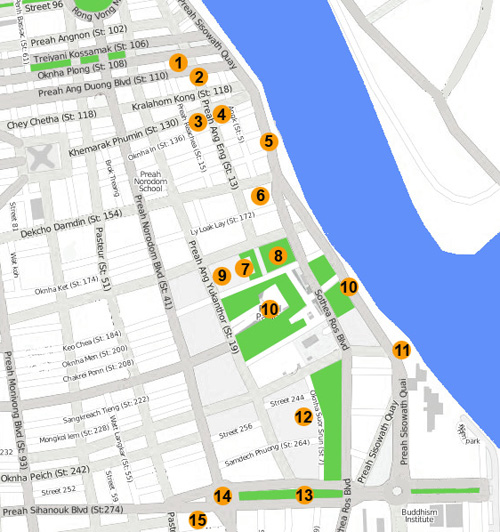Last updated on December 5th, 2018
Phnom Penh River Front Walking Tour

VISITING PHNOM PENH
Phnom Penh is relatively compact and you’ll get your bearings quickly. The Monument of Independence sits at the centre, with Monivong and Norodom Boulevards (appropriately named after Kings) as main thoroughfares. Most sights and activities are within easy reach if you choose accommodation in the area.
1. Phsar Chas (Old Market)
The Old Market is located at the North end of Street 13 (also called Ang Eng or Ohier Street), one of the main historic commercial streets in Phnom Penh.
2. Street 13 (Ang Eng / Ohier Street)
This historic street runs from the Post Office square to the North, to the National Museum to the South. Different styles of shophouses and apartment blocks can be found in this area. It is interesting to notice the differences in number of storeys, details and decorations, as well as in space use : internal courtyards, balconies or external corridors, covered pathways at street level etc.
3. Hôtel International (Corner of Street 130 and Street 13)
This building, which is no longer a hotel, was built between 1890 and 1910.
4. Mixed Use Building (Corner of Street 130 and Street 5)
This building dates back to 1918 and its architecture is unique in Phnom Penh today. Spaces are organised around a central patio and staircase. This allows air to circulate and cool the building. As in most of the buildings in the area, the ground floor was used -and still is- for commercial purposes, and living quarters are located above.
5. Sisowath Quay and Gardens
Enjoy a fresh coconut and some lotus seeds by the river.
6. Wat Ounalom
The Wat was founded in the early 15th century by King Ponhea Yat and is one of Phnom Penh’s most important religious centres. Although it is one of the oldest wats, most of the present buildings were built after the 1950s. The stupa to the west of the main hall is said to contain Buddha relics.
7. Phnom Penh National Museum
The Phnom Penh National Museum was designed by Georges Groslier and built between 1917 and 1920. The building integrated Cambodian architectural elements and used concrete, an ‘imported’ construction material, used mainly in European-inspired buildings at the time. The main building was first extended in the 1920’s, then restructured in the late 1960’s. Around the same date, water features were added in the internal courtyard garden. After the civil war, the museum was abandoned. Since its reopening in 1979, the buildings have undergone many restorations. Phnom Penh National Museum houses collections of Khmer art mainly from the pre, post-Angkorian and Angkorian periods.
8. Veal Mean and Street 178
In front of the National Museum is the Veal Mean esplanade. This open space offers perspectives on the Museum as well as on rows of shophouses on street 178, villas, the Royal Palace and the river. Every year the Royal Ploughing ceremony, during which sacred oxen help predict the upcoming year’s harvest, takes place here. Art workshops and galleries line street 178.
9. School of Fine Arts (Street 19 / Street 184)
The School of Fine Arts lies just behind the museum and its older buildings are said to have been constructed between 1925 and the 1950s.
10. Royal Palace and Public Space along Sisowath Quay
The palace was built after 1866. Since then, buildings have been demolished and added, and the actual layout and forms date back to the 1960s. Their design reflects a mix of Khmer and European influences. The palace faces a special site : the confluence of the Bassac, Tonle Sap and Mekong Rivers.
11. Chaktomuk Conference Hall and Theatre
Further south along the river lies the Chaktomuk Theatre. The name ‘Chaktomuk’, meaning Four Faces, refers to the four ‘arms’ created by the confluence of the three rivers. The theatre was designed by Vann Molyvann and built in 1961. It reinterprets traditional khmer elements such as the pointed ‘tower’ and triangle roof forms which open out like a fan seen from above. The Chaktomuk Conference Hall and Theatre is a significant example of post-independence Khmer Architecture.
12. Wat Botum Vadei and Esplanade
The wat was founded in 1442 under the name Wat Khoop Ta Yan. However over the years, as it is the case in most wats, buildings and structures were renovated and rebuilt. The main stupa that can be seen today was constructed in 1865 and contains Buddha’s ashes. Some of the smaller stupas contain ashes from members of the royal family.
13. Esplanade Leading to the Independence Monument
Flamboyants, named after the bright red colour of their flowers, line the esplanade and boulevard. Part of this open space, as well as the Independence Monument were built on reclaimed land.
14. Independence Monument
Inspired by the temple of Banteay Srey, the seven-tiered monument was designed by Vann Molyvann and inaugurated in 1962.
15. Wat Lanka
Wat Lanka was founded in 1422 close to Wat Phnom. It was later moved to its present position in the late 19th century.
![]()
If you find our blog useful, please consider making a hotel or flight booking with our affiliate links. Happy travels!
